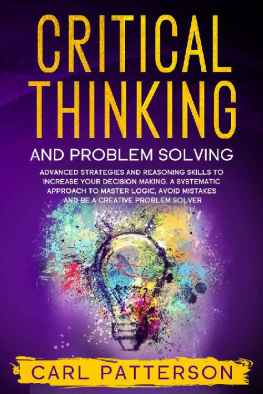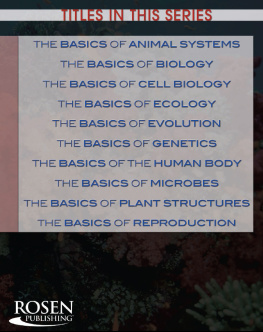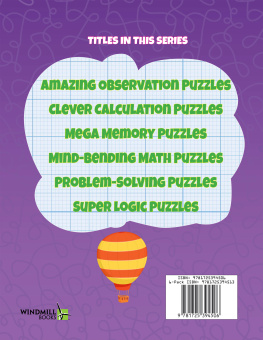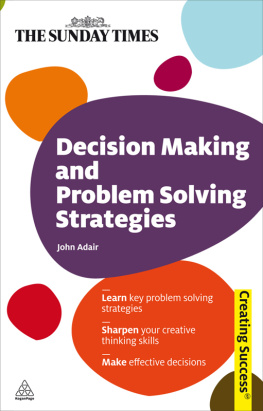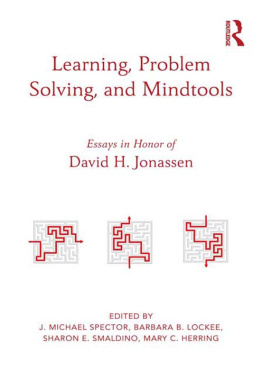Table of Contents
List of Illustrations
- Chapter 1
- Chapter 2
- Chapter 3
- Chapter 4
- Chapter 5
- Chapter 6
- Chapter 7
- Chapter 8
- Chapter 9
Guide
Pages
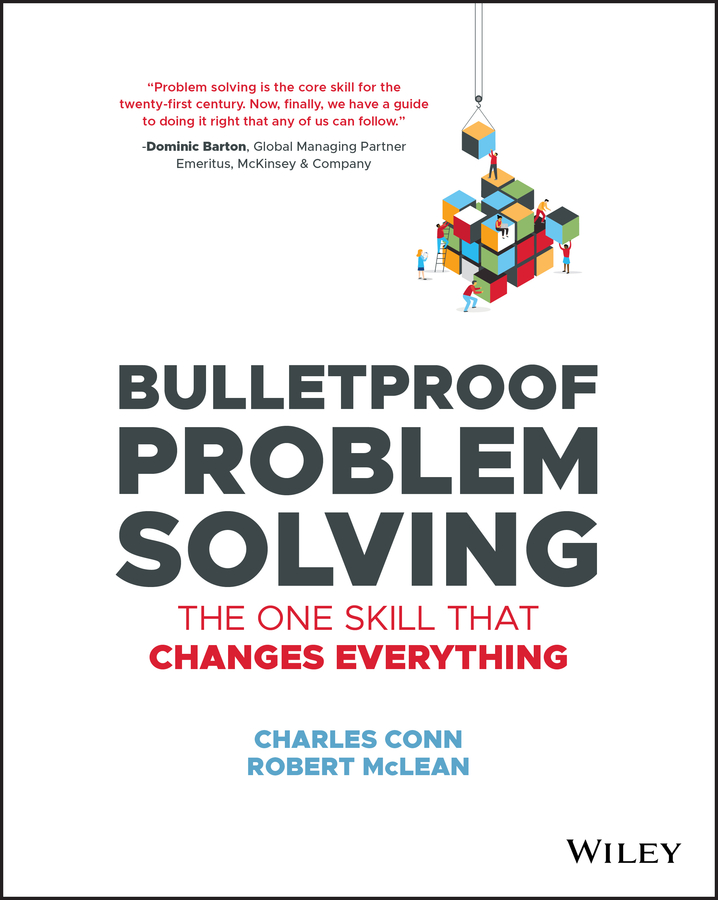
Bulletproof Problem Solving
Charles Conn and Robert McLean

Praise for Bulletproof Problem Solving
The Bulletproof Problem Solving approach acknowledges the reality many environmentalists face today: this is hard work. Conn and McLean's guide makes it a little bit easier.
Mark R. Tercek, CEO of The Nature Conservancy and author of Nature's Fortune
Conn and McLean have distilled their matchless experience in attacking challenges of every scale and level of complexity into this virtual warroom of a book, creating an indispensable resource for the 21st century problemsolvers upon whom our future depends. A mustread for all aspiring change agents!
Sally Osberg, retired CEO of the Skoll Foundation, coauthor of Getting Beyond Better: How Social Entrepreneurship Works
Navigating ambiguity and solving complex problems creatively is the truth test for humans to complement rather than substitute the artificial intelligence of computers. Without much better approaches to teach those skills, our schools risk preparing second class robots rather than first class humans. Rob McLean and Charles Conn show that this can be done and provide an intuitive roadmap for how to do this, with lots of realworld examples that make it fun.
Andreas Schleicher, Director for the Directorate of Education and Skills, OECD
Great strategic problem solving is an essential tool, one whose value is only going up. Bulletproof provides the secret sauce behind the McKinsey framework to help structure and guide the problemsolving process. I want to hire people who understand this approach.
Barry Nalebuff, Milton Steinbach Professor, Yale School of Management and cofounder, Honest Tea
The old paradigm of strategy departments and planning cycles has been overthrown by agile and rapid teambased problem solving, providing better solutions and better organization alignment to implement. This book, written by two of the smartest people I know, provides the needed blueprint for how build these worldbeating problem solving teams.
Mehrdad Baghai, Chair of Alchemy Growth and author of As One
The world has never been in more need of extraordinary problem solversin business and every other walk of life. Rob McLean and Charles Conn powerfully demonstrate that problem solving is a structured process that can be learned and applied to the benefit of everybody. Their book is such an important contribution to the resolution of our biggest problem solving challenges.
Nick Lovegrove, Professor of the Practice, Georgetown University and author of The Mosaic Principle
Copyright 2018 by Charles Conn and Robert McLean. All rights reserved.
Published by John Wiley & Sons, Inc., Hoboken, New Jersey.
Published simultaneously in Canada.
No part of this publication may be reproduced, stored in a retrieval system, or transmitted in any form or by any means, electronic, mechanical, photocopying, recording, scanning, or otherwise, except as permitted under Section 107 or 108 of the 1976 United States Copyright Act, without either the prior written permission of the Publisher, or authorization through payment of the appropriate percopy fee to the Copyright Clearance Center, Inc., 222 Rosewood Drive, Danvers, MA 01923, (978) 7508400, fax (978) 6468600, or on the Web at www.copyright.com. Requests to the Publisher for permission should be addressed to the Permissions Department, John Wiley & Sons, Inc., 111 River Street, Hoboken, NJ 07030, (201) 7486011, fax (201) 7486008, or online at www.wiley.com/go/permissions.
Limit of Liability/Disclaimer of Warranty: While the publisher and author have used their best efforts in preparing this book, they make no representations or warranties with respect to the accuracy or completeness of the contents of this book and specifically disclaim any implied warranties of merchantability or fitness for a particular purpose. No warranty may be created or extended by sales representatives or written sales materials. The advice and strategies contained herein may not be suitable for your situation. You should consult with a professional where appropriate. Neither the publisher nor author shall be liable for any loss of profit or any other commercial damages, including but not limited to special, incidental, consequential, or other damages.
For general information on our other products and services or for technical support, please contact our Customer Care Department within the United States at (800) 7622974, outside the United States at (317) 5723993, or fax (317) 5724002.
Wiley publishes in a variety of print and electronic formats and by printondemand. Some material included with standard print versions of this book may not be included in ebooks or in printondemand. If this book refers to media such as a CD or DVD that is not included in the version you purchased, you may download this material at http://booksupport.wiley.com. For more information about Wiley products, visit www.wiley.com.
Library of Congress CataloginginPublication Data is Available:
ISBN 9781119553021 (Paperback)
ISBN 9781119553045 (ePDF)
ISBN 9781119553038 (ePub)
Cover Design: Wiley
Cover Image: Marish/Shutterstock
Foreword
Bulletproof. At McKinsey there is no greater compliment than to have your reputation as a problem solver described as bulletproof. While it takes many skills and types of intelligence to make a modern consulting firm work, the cornerstone capability is always creative problem solving.
The importance of great problem solving has only grown as the pace of economic and technological change has accelerated in recent yearsand the scope and complexity of the problems we need to address increases alongside it. Today we are just as likely to be hired to help a country public health system prepare for the next Ebola outbreak as to develop a digital marketing strategy for a new consumer product. As ever more data becomes available, the bar on the quality of thinking rises. We need bulletproof problem solvers.
Whether you work in industry, the nonprofit sector, or government, there is no way to anticipate and plan for the new structures and operating rules that are unfolding. Nor is simply accelerating and adapting traditional, domainoriented, training approaches sufficient. The only way to successfully navigate this level of change is to be a fluid and creative problem solver. That's why the World Economic Forum labeled complex problem solving its number one skill for the twentyfirst century. Organizations everywhere are looking for this capability in their talent recruiting above all else.
What is perhaps surprising is that a disciplined, comprehensive approach to problem solving isn't taught in schools or universities. It is absent from most curricula even in many business schools. You can see elements in things like rootcause analysis or the current vogue for agile teams and design thinking, but they don't go far enough. This book introduces the systematic process for problem solving that has been missing, a version of the timetested methodology we have used for many years in McKinsey.


